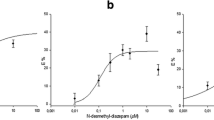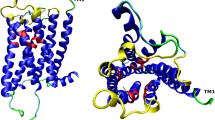Abstract
The allosteric effects of adrenotropic drugs and the membranotropic agent cocaine on the kinetics of [3H]quinuclidinyl benzylate ([3H]QNB) binding to muscarine cholinoceptors of synaptosomal membranes of rat cerebral cortex were studied. In control, the best results were obtained for the model that assumes the existence of two receptor pools (with high and low affinity) with calculated parameters of the activity (K d), amount (B max), and mono- to dimer receptors ratio (n). For the high-affinity receptors these parameters were K d1 = 0.18 ± 0.08 nM, B m1 = 221.2 ± 56.7 fmol/mg protein, n 1 = 2, and for low-affinity receptors, K d2 = 1.33 ± 0.11 nM, B m2 = 748.7 ± 53.3 fmol/mg protein, n 2 = 2. Allosteric modulation of the activity of specific neurotransmitter receptors can be accomplished by changing the receptor affinity and amount as well as the proportion of mono- and dimer receptors. Under control conditions, muscarine receptors exist as dimers. In the presence of α-adrenoreceptor agonist noradrenaline and β-adrenoreceptor antagonist propranolol, only one pool of the dimer muscarine receptors remains. The number of binding sites for noradrenaline and propranolol decreases approximately by 40% and 20%, respectively. The agonist of α2-adrenoreceptors clonidine, the antagonist of α2-adrenoreceptors yohimbine, and a membranotropic agent cocaine change the ligand binding so that only one receptor pool remains but some of the dimer receptors become monomeric (1 < n < 2). The amount of binding sites reduces by 20%, 25%, and 45% for clonidine, yohimbine, and cocaine, respectively.
Similar content being viewed by others
References
Baker, D.G., Don, H.F., and Brown, J.K., α-Adrenergic and Muscarinic Cholinergic Inhibition of ACh Release in Guinea Pig Trachea: Role of Neuronal K+ Channels, Am. J. Physiol., 1994, vol. 266, no. 6 (part 1), pp. 698–704.
Schramm, C.M., Arjona, N.C., and Grunstein, M.M., Role of Muscarinic M2 Receptors in Regulating β-Adrenergic Responsiveness in Maturing Rabbit Airway Smooth Muscle, Am. J. Physiol., 1995, vol. 269, pp. 783–790.
Manukhin, B.N., Nesterova, L.A., and Smurova, E.A., Effects of the α1-Adrenoreceptor Agonist Methoxamine, the M-Cholinoreceptor Antagonist Atropine, and the Membranotropic Agent Cocaine on the Binding of [3H]Dihydroalprenolol to α-Adrenoreceprors on Rat Red Blood Cells, Biologicheskie membrany (Rus.), 2001, vol. 18, no. 4, pp. 277–282.
Manukhin, B.N. and Nesterova, L.A., The Kinetics of the Reaction of the Rat Portal Vein Responses to Catecholamine and Acetylcholine, Fiziol. Zhurnal im. Sechenova (Rus.), 1994, vol. 80, no. 2, pp. 68–76.
Henn, S.W. and Henn, F.A., The Identification of Subcellular Fractions of the Central Nervous System, Handbook of Neurochemistry, Lajtha, A., Ed., N.Y., London, Plenum Press, 1982, pp. 147–161.
Manukhin, B.N., Smurova, E.A., and Nesterova, L.A., Characteristics of Binding of Specific Antagonist [3H] Quinuclidinyl Benzylate by M-Cholinoreceptors in Rat Cerebral Cortex, DAN (Rus.), 1995, vol. 343, no. 2, pp. 268–271.
Lowry, O.H., Rosenbrough, N.J., Farr, A L., and Randall, R.I.J., Protein Measurement with the Folin Phenol Reagent, J. Biol. Chem. 1951, vol. 193, pp. 265–275.
Manukhin, B.N., Nesterova, L.A., and Smurova, E.A., Characteristics of the Kinetics of Interaction between β-Adrenoreceptors of Rat Erythrocytes and a Specific Blocker Propranolol, Membr. And Cell Biol., 1995, vol. 8, pp. 485–489.
Manukhin, B.N., Nesterova, L.A., Smurova, E.A., and Kichikulova, T.P., An Approach to Analysis of Rradiolabeled Ligand Interaction with Specific Rreceptors, Eur. J. Pharmacol., 1999, vol. 366, nos. 2–3, pp. 279–288.
Dixon, M. and Webb, A., Fermenty (Enzymes), Mir, Moscow, 1982, vol. 3.
Keleti, T., Osnovy fermentativnoi kinetiki (Basics of Enzyme Kinetics), Mir, Moscow, 1990.
Hill, A.V., The Possible Effects of the Aggregation of the Molecules of Hemoglobin on Its Dissociation Curves, J. Physiol., 1910, vol. 40, Proceed. Physiol. Soc., pp. iv–vii.
Berezov, T.T. and Korovkin, B.F., Biologicheskaya Khimiya (Biological Chemistry), Meditsyna, Moscow, 2007.
Avdonin, P.V., Structure and Signaling Properties of G-Protein-Coupled Receptor Complexes. Biologicheskie membrany (Rus.), 2005, vol. 22, no. 1, pp. 3–26.
Uberti, M.A., Hall, R.A., and Minneman, K.P., Subtipespecific Dimerization of α1-Adrenoceptors: Effects on Receptor Expression and Pharmacological Properties, Mol. Pharmacol., 2003, vol. 64, no. 6, pp. 1379–1390.
Small, K.M., Schwarb, M.R., Glinka, C., Theiss, C.T., Brown, K.M., Seman, C.A., and Liggett, S.B., α2A- and α2C-Adrenergic Receptors form Homo- and Heterodimers: The Heterodimeric State Impairs Agonistpromoted GRK Phosphorylation and β-Arrestin Recruitment, Biochemistry, 2006, vol. 45, no. 15, pp. 4760–4767.
Hague, C., Lee, S.E., Chen, Z., Prinster, S.C., Hall, R.A., and Minneman, K.P., Heterodimers of α1B- and α1D-Adrenergic Receptors form a Single Functional Entity, Mol. Pharmacol., 2006, vol. 69,no. 1, pp. 45–55.
Nobles, M., Benians, A., and Tinker, A., Heterotrimeric G Proteins Precouple with G Protein-coupled Receptors in Living Cells, Proc. Natl. Acad. Sci. USA, 2005, vol. 102, no. 51, pp. 18706–18711.
Trankle, C., Mies-Klomfass, E., Botero Cid, M.H., Holzgrabe, U., and Mohr, K., Identification of a [3H]Ligand for the Common Allosteric Site of Muscarinic Acetylcholine M2 Receptors, Mol. Pharmacol., 1998, vol. 54,no. 1, pp. 139–145.
Tucek, A., Jakubik, J., Dolezal, V., and El-Fakahany, E.E., Positive Effects of Allosteric Modulators on the Binding Properties and the Function of Muscarinic Acetylcholine Receptors, J. Physiol. (Paris), 1998, vol. 92, nos. 3–4, pp. 241–243.
Holzgrabe, U., de Amici, M., and Mohr, K., Allosteric Modulators and Selective Agonists of Muscarinic Receptors, J. Mol. Neurosci. 2006, vol. 30, nos. 1–2, pp. 165–168.
Christopoulos, A., Lansafame, A., and Mitchelson, F., Allosteric Interaction at Muscarinic Cholinoceptors, Clin. Exp. Pharm. Physiol., 1998, vol. 25, pp. 185–194.
Birdsall, N.J.H., Farries, T., Charagozloo, P., Kobayashi, S., Lazareeno, S., and Sugimoto, M., Subtype-selective Positive Cooperative Interactions between Brucine Analogs and Acetylcholine at Muscarinic Receptors: Functional Studies, Mol. Pharmacol., 1999, vol. 55, no. 4, pp. 778–786.
Yu, X.C., Wang, H.X., Zhang, W.N., and Wong, T.M.J., Cross-talk between Cardiac κ-Opioid and β-Adrenergic Receptors in Developing Hypertensive Rats, J. Mol. Cell Cardiol., 1999, vol. 31, no. 3, pp. 597–605.
Author information
Authors and Affiliations
Corresponding author
Additional information
Original Russian Text © B.N. Manukhin, L.A. Nesterova, 2009, published in Biologicheskie Membrany, 2009, Vol. 26, No. 2, pp. 104–110.
The article was translated by the authors.
Rights and permissions
About this article
Cite this article
Manukhin, B.N., Nesterova, L.A. Allosteric modulation of the [3H]quinuclidinyl benzylate binding to M-cholinoreceptors in rat cerebral cortex by adrenotropic agents. Biochem. Moscow Suppl. Ser. A 3, 151–156 (2009). https://doi.org/10.1134/S199074780902007X
Received:
Published:
Issue Date:
DOI: https://doi.org/10.1134/S199074780902007X




